Dhasavathara Sthalangal
- Address: Chennai, INDIA
- Tags:
 What to see Chennai,
Chennai,
India
What to see Chennai,
Chennai,
India
VISHNUISM AND DARWINISM
Hello guys! How are you all? Hope you are all doing great and today I am going to share with you one of the very interesting topics of controversy in Hinduism, the Vaishnavism.
Before digging more into this topic, I would like to recollect some of my childhood memories. All those days, even now, I used to argue a lot about everything with my parents and I never accepted anything they said but I kept arguing without taking their age or their experience into account. Now I feel really stupid about the way I looked into the world and neglecting their experience about life. But, leaving all those sad arguing parts behind, the good thing about it, is that I have a new topic for my blog as we had some discussions and arguments about Vaishnavism too.
Vishnu in Sanskrit means "the supreme"
It is the vedic God of the Vaishnavas. He is also commonly known as the Narayana or Sri Hari. The Smartargal who followed Adi Shankarar describe Vishnu as one of the five main gods of Hinduism. The Hindus believe Sri Maha Vishnu as the all pervading God, and he is assumed to be the lord of all beings, the master of past, present and future and the protector, and ultimate ruler of the universe. It is said that Lord Maha Vishnu is present from everything to anything ("perumal thoonilum irupaar, thurumbilum irupaar") as mentioned by Prahalathan.
The Trinity of the hindu gods is assigned to have the following functions:
01. Brahma: The Creator
02. Vishnu: The Protector
03. Shiva: The Destroyer
Lord Vishnu is often described in the colour of blue rain braught by clouds, with four hands holding a shankha (conch), a chakra (war discus), a padma (lotus flower) and gada (mace). However, some astrologers say that Vishnu himself is not blue in color and most of his pictures are the depictions of Lord Krishna and Lord Rama, who are incarnations of Maha Vishnu. The Bhagavat-gita mentions that he is the one who is present in all forms on this earth.
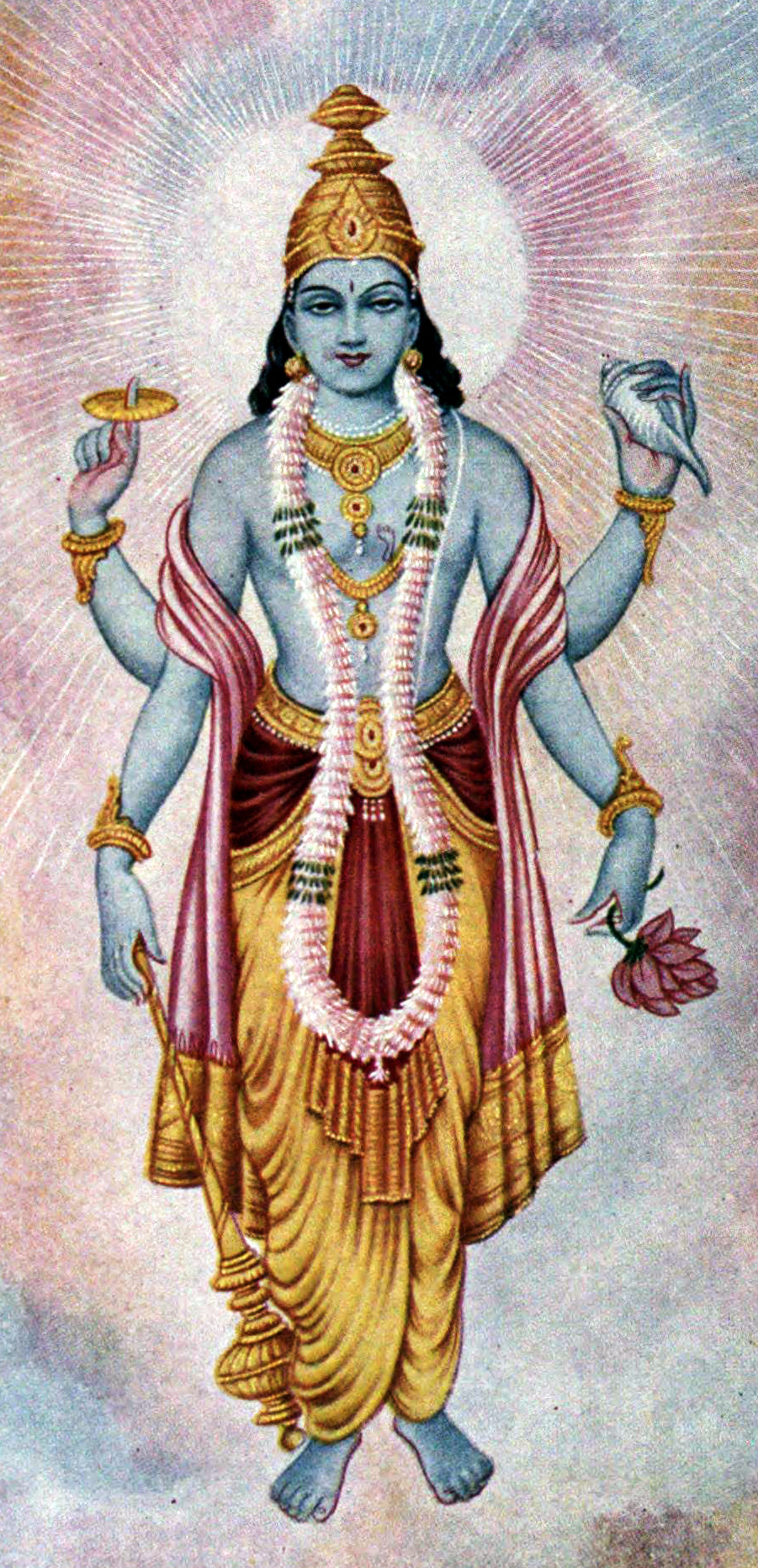
Perumal is assumed to be living in a place called Vaikundham which can be translated in Sanskrit as "ethernal bliss and happiness". He is also known as Parandhaman, which means "the one who takes the decisions on how one's life has to be after death" which is like Moksha (the last janm) or being re-born in this world.
According to the Hindu view of what life is like "every man has to undergo a minimum of seven "janmon" (births)" in which he will be born as each and every form of the living and non living beings. The first one is being humans and the second to last or 6th is a dog. The final one is a human form after which, the person may attain "moksha". A person who has never sinned in this "janm" will never have to suffer as much as the person who sinned in their re-births.
Hindus still consider life on earth is full of miseries and sorrows and the complete ethernal bliss will be obtained by attaining a state of freedom from being born again in this universe. Birth is sorrowful and the human form is the worst punishment of the Lord to us. This is the reason why every sage, saint or "sadhu" known to the world preaches everybody not to exceed the limit of sins as they will suffer again. That is why people often tend to be pressured that to attain "moksha" one must strictly go in "thuravaram" (renunciation of all worldly pleasures). This world renunciation means to get away from everything. This "thuravaram" is considered as one of the very great practices of ancient periods by Hindus but now there is a hell lot of people who misuse it. So what "thuravarm" actually is, according to the tamil definition, is "thuravu", leaving everything behind, discipline.
So, now the question to pop into everybody's mind is: What are these disciplines of the "sannyasa"?
"Sannyasa" per se, is one of the stages of life, which are:
A male child would live with his family until he is older. Then, he will be sent to a "gurukulam" (the house of a guru) and he would typically live with his teacher, acquiring knowledge about the vedas first and some other fields depending on his interests and his parents wishes; along with science, philosophy, scriptures and logic, practising self discipline and learning to live a life of "dharma".
It is believed that before a man can get enlightened he should have had all the stages of life and according to this fact, a man who wishes to become a "sannyasi" should also spend their life enjoying a family life, carrying out ones duties for his family and society contributing with a gainful labour.
After the completion of one's household duties, one gradually withdraws from the world, freely shares wisdom with others, and prepares for the complete renunciation of the final stage.
One will completely withdraw from the world and starts dedicating to spiritual pursuits, the seeking of "moksha" and practicing to that end. Out of all the four stages of life, the life of a Sannyasi is a little tough and the most praised. There are also people who have become "sannyasa" right from "brahmacharya" without being a "grahasta". A male in the "sannyasa" order is known as "sannyasin" (male) and "sannyasini" (female).
"Vishnu is one of the prominent names the protector has"
His other abode within the material universe is Ksheera Sagara (Paarkadal, the ocean of milk), where he reclines and rests on Aadi Sheshan. It is believed that Lord Maha Vishnu is the most supreme of the trinities of Hindu gods. It is believed that Vishnu protects the universe from there. The name Vishnu is one of the prominent names the protector has. The number of auspicious qualities Maha Vishnu has is countless with 6 of them being the main and the most important qualities.
01. Gnanam: It is the power to know about all beings simultaneously and in order to enhance the praise to Maha vishnu, it is often said to people that "katradhu kai man alavu; kallathathu ulagalavu", which is tranlated as "the things you know are just a drop in an ocean", where the term "ocean" represents the Ksheera Sagara.
02. Aishvaryam: It is the adverb of "ishvara" which consists of an unchallenged rule over all.
03. Shakti: It represents the energy or the power, which gives it the capacity to transform the impossible into possible.
04. Balam: It represents the strength, which is the capacity to support everything by will and without any hindrance.
05. Viryam: It indicates the power to retain immateriality as the supreme being in spite of being the material cause of mutable creations.
06. Tejas: It expresses his self-suffiency and his capacity to overpower everything by his spiritual effulgence.
Narayana and Rigveda
Veda's view of Vishnu accords with Yajurveda, Lord Narayana is mentioned as the supreme being. The first verse of Narayana Sukta says "paraman padham" which literally means "the feet of the supreme of all souls". In Rigveda, a special status is given to Lord Vishnu only and not to any other deity (God or his statues) apart from him. Thus, Lord being Vishnu himself, thus establishing his supremacy. Narayana is one of the names given to Lord Vishnu as for Vishnu Sahasranama. In the Rigveda, Vishnu is mentioned 93 times. He is frequently invoked along side other deities, especially Indra, who helps Vishnu to kill Vritra. However, the story behind that is told in different ways according to different puranas and vedas.
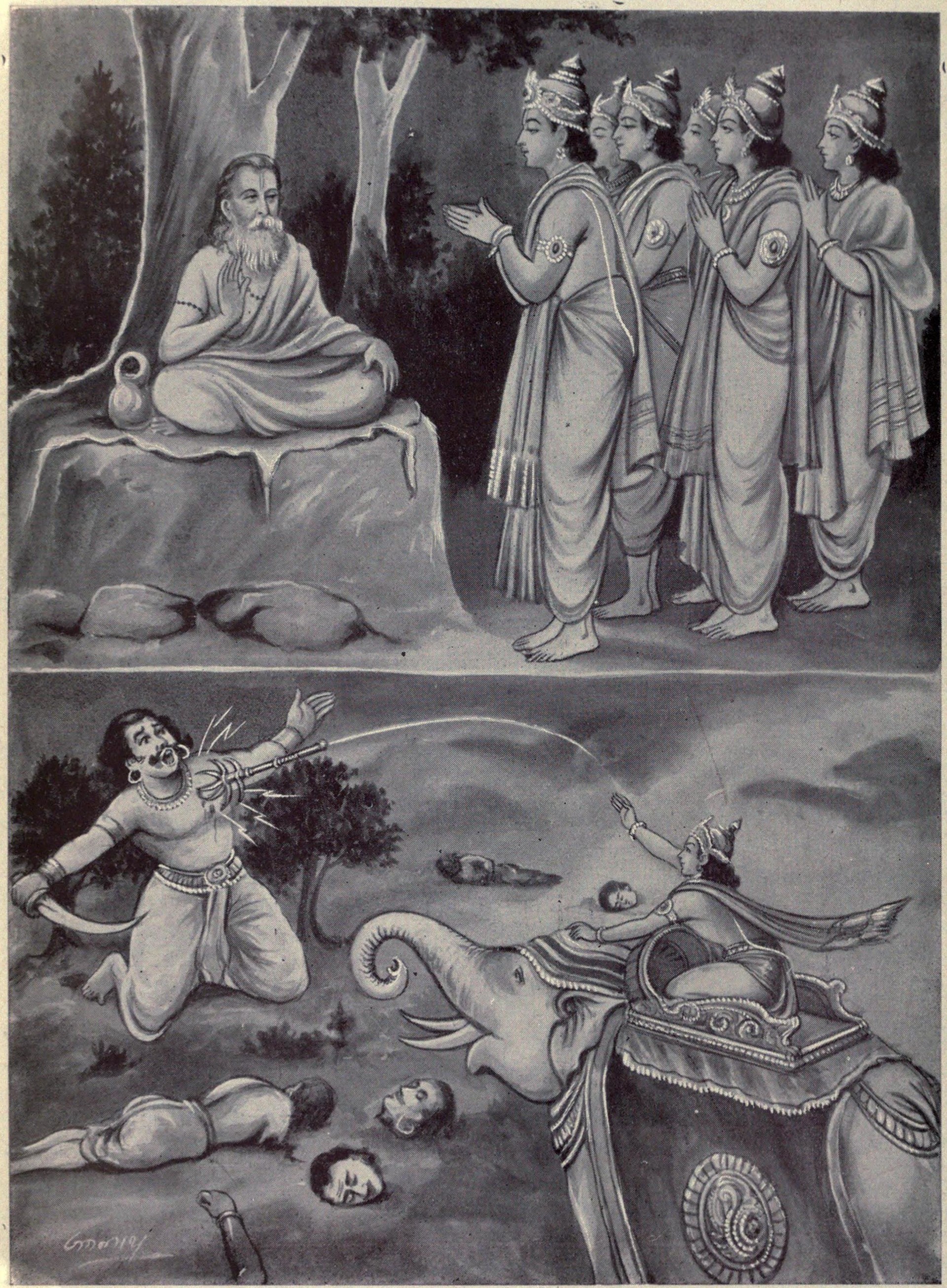
According to Rigveda, Vritra kept the waters of the world captive until he knew he was going to be killed by Indra, who destroyed all the 99 fortress of Vritra before liberating all the rivers. The combat began soon after Indra was born, and he had drunk a large volume of soma at Tvasthashtri's house to empower himself before facing Vritra.
They then fashioned the thunderbolt (vajrayudha) for Indra, and Vishnu, when asked to do so by Indra, made space for the battle by taking three great strides for whom Vishnu became famous. Vritra broke Indra's jaws during the battle, but was then thrown down by Indra and, when falling, he crushed the fortresses that had already been shattered. For this shed, Indra became known as vitrahan "the slayer if Vritra" and also as "slayer of the first-born of dragons". Vritra's mother danu, (who was also the mother of the Danava race of Asuras), was then attacked and defeated by Indra with his thunderbolt.
In one of the versions of the story, three Dhevargal- Varuna, Soma and Agni - were coaxed by Indra into aiding him in the fight against Vritra whereas before they had been on the side of Vritra (who they called "father"). In one verse of a Rigvedic hymn eulogising Sarasvati, the latter is credited with the slaying of Vritra.
In a later versions of the myth, Vritra was created by Tvashithri to avenge the killing of his son by Indra, known as Trisiras or Visvarupa. Vritra won the battle and swallowed Indra, but the other gods forced him to get Indra out. The battle continued and Indra eventually had to flee. The battle continued, Vishnu and Rishi broke a truce with Indra, who was eventually made to swear that he would not attack Vritra with anything made of metal, wood or stone, nor anything that was dry or wet, or during the day or the night. Indra used the foam (which Vishnu had entered to ensure victory) from the waves of the ocean to kill him at twilight.
However, in some places, Hindu scriptures also recogonize Vritra as a Bhakta of Vishnu who was slain only due to his failure to live piously and without aggression. The story tells that Vritra, a Brahmin in this version, became the head of Asuras (portrayed as inherently demonic, as opposed by vedic versions in which they can be gods or demons). He renounced his Dharma, duty to do good to others and turned violent, battling with Devas. Eventually, he gained the upper strength and the Devas were all frightened of his evils. Led by Indra, they all approached Lord Vishnu for help. He told them Vritra could not be destroyed by ordinary means, revealing that the only weapon that could kill Vritra will be a weapon that will be made from the bones of a sage (Rishi) Dadhichi. When approached by gods, Dadhichi Maharishi gladly gave up his bones for the cause of goodness, stating that it would be better for his bones to be used for the cause of good than to rot in the ground. The devas collected the bones and Indra crafted the vajrayutha from them. When they engaged Vritra again, the battle lasted for 360 days before the Brahmin breathed his last. It is believed that this paavam (inocence) of killing a Brahmin did not leave Indra and thus, he was forced to flee (run for his life) and hide himself.
Then Nahusha, a well known king of the Aliyan dynasty, came in to rule the Devas in place of Indra. According to puranas, king Aayu and his wife Indhu Mathy, happily had a son. But on the night when the baby was born a maid lifted the sleeping child and took him in to the sky. In fact she was not a maid, she was Asura Hund (and Hund is his name). Hund brought the baby and handed over him to his wife and ordered her to cook a delicious dish for him. They could not kill the child, so she gave him to a man who took him away and left him on the doorstep of sage Vasishta. It was in the morning and sage Vashista was going to start doing his morning chores when he saw the new-born child on his doorstep. He picked him up in his arms and named him Nahusha. On the other side, Aayu and his wife were weeping for their child, so Narada arrived and consoled them by telling them that their child was safe.
The story behind how he became cursed was, after the flee of Indra. As he became Indra at one time, he lusted after the current Indrani, Sachi (queen of the Devas and the previous Indra's wife). He sent a message to Indrani saying that as he had become the new Indra, he was comming to her palace. Indrani got worried but could not do anything, so she went to the guru of the Devas, Brihaspati, and told him her problem. He sugested that she should ask him to come in a pallaquin carried by Sadhu and Munivars. She laid the condition to Nahusha. In his arrogance, Nahusha did not carry out this impropriety and asked the sages to be his bearers. They sages were not used to this work, so they were moving slowly. One particular sage, Agasthiyar, who was short in stature, was moving very slowly. Nahusha was in a hurry to meet the Indrani, so kept shouting "sarpa sapa" (in Sanskrit words have more than one meaning, like here where "sarpa" means "snake" but "Nahusha" meant "go fast" which is another meaning here). At one point, he goaded Agastya with his one leg and said "kudumba dimba sarpa sarpa". "Kudumba dimpa" means "the one who came from a pot" and Agastya is believed to have been come from a pot. The enraged Agastya retailingly cursed him as "sarpo bhava" (become a snake). King Nahusha turned into a snake and fell down to earth. Sage Narada intervened on his behalf and Agastya relented and said that Yudhisthra would be instrumental in Nahusha's release from the curse.

The general views is that vedas place Indra in considerable superior position to Vishnu's avatar of Vamana. Vamana helps Indra by restoring his kingdom as mentioned in vamana purana. Jan Gonda, the late indologist, states that Vishnu, although remaining in the background of Indra's exploits, contributes by his presence or is the key to Indra's sucess. Vishnu is more than a mere companion, equal in rank or power to Indra, or some time the one who made Indra's sucess possible.
Moreover, even when Vishnu is described as sub-ordinate to Indra, such a depiction is found in only hymns to Indra, but according to Rigveda, each and every God for time being, is supreme in the mind of the devotee. On the other hand, in the Vaishnava cannon the "Vishnu" who is subordiante to Indra is identified only in the Vamana avatar and he is entirely different from the supreme God, Narayana who is refered to as Vishnu by Vaishnavites. Vishnu is not a mere sacrificial deity; he is a God who lives in the highest celestial region compared with those who live in the athmospheric or terrestrial regions. Moreover, Vishnu is a God who is content with mere prayer, unlike almost all of the other gods who receive sacrificial offerings such as soma. Yet, in the Rigvedic texts, the deity or God refered to as Vishnu is none other than Sun God, who also is called as "Surya Narayanar", who is also called as Lord Vishnu. So the Vishnu refered according to this Rigveda read by none other than the "Sun God Surya Narayana" or "Surya Adn", is entirely different from the Vishnu who is "Sreeman Narayana", who is Vishnu. "Vishnu Sahasranamam" identifies very clearly as not the sun but as the "Surya Narayanar" (the purveyor of the skies), but as Narayana or Vishnu and further, he is identified as the supreme being.
The Vaishnavites make some further distinction by extolling the qualities of Vishnu Narayana by highlighting him as a personality or entity much different from other deities like Surya, Brahma or Ahiva who may also bear some names of Vishnu. In puranas, Indra frequently becomes proud and haughty. This act of him caused displeasure of his creators, namely Brahma along with Shiva the destroyer and they started giving boons to the Asuras like Ravana, Hiranyaksha, etc., who were able to defeat Indra in wars between Devas and Asuras. Indra, indeed, had no other way than taking advice from sages who will in turn him in and send him to request Sriman Narayana the protector. Indra would then go and plead and pray to Lord Vishnu for protection and the Paramathma saves the earth by taking Avataras to protect the world.
Relationship with Darwinism
As you read the paragraph below, you will understand that Vaishanavism proved Darwinism centuries ahead of Charles Darwin.
The orders of incarnation are as followed and the first six are very important in them:
01. Macha Avatharam (fish): Life starts in water (600 million to 400 million years ago).
02. Kurmam Avatharam (turtle): The first amphibians emerged (100 million years ago).
03. Varaham Avatharam (boar): The first mammals evolved (60 million years ago).
04. Narasimha Avatharam (half man and half lion)They appeared (30 million years before).
05. Vamana Avatharam (dwarf): Homo-Erectus, upright, yet short and weaponless (5 million to 2 million years ago).
06. Parashurama Avatharam (parashu - axe; rama - name of the God): Bronze age; the coming of Ramapithecus; development of the first weapon axe and Homo sapiens (350 thousand years - 100 thousand years ago).
07. Rama Avatharam (prince)
08. Krishna Avatharam (cow-herd)
09. Buddha Avatharam / Balarama Avataram (sage)
10. Kalki (horseman, who has not yet appeared)
Let's now learn in detail about the pourpose of these Avatharas.
01. Matsya
It is believed that Lord Vishnu incarnated as a fish in the world.
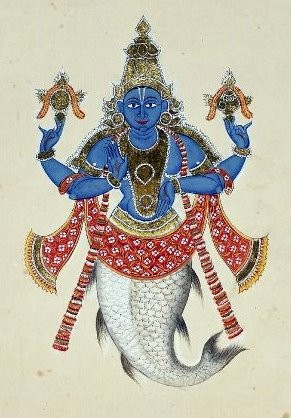
In the earliest yuga of Satya yuga there lived a Maharaja named "Manu". He was performing a tremendous thapas (penance) for almost thousands of years. One day, when he was performing ablutions with river water, a small fish came into his hands and just as the way when he was about to throw that fish back into the water, the fish begged him to save its life. So the king put the fish into a jar of water but then, the fish started growing and the jar was not big enough for it. Then, the king threw it into the river but it still grew big and then he threw it into the Ganges and then into the Samudra (ocean). The fish did not stop growing and the king soon realised that it was Maha Vishnu himself and then Lord Parabrahma made an appearence and asked for a speacial request to the king.
He predicted that the world would come to an end by a huge flood in seven days and requested the king to build a huge boat and take the seven sages (hermits), seeds of all plants, one animal of each type and told him that he would appear as a fish and propel the boat to Mount Himavan for surviving the flood to the next yuga. True to his word, after seven days the Lord appeared and the king tied the boat to the fish by using the royal serpent Vasugi, and the fish took all of them to Humavan and kept them there until the flood was over and the new era king started the pro-creation for the new-era.
02. Kurma Avatharam
In Kurma Avatharam, Lord Vishnu incarnates himself as turtle.

It is an interesting story involving both the Devargal (gods) and the Asurargal (demons). In the on-going saga of battle between the gods and the Asuras, on one occasion, the gods suddenly lost all their strength due to the curse by the short-tempered sage Durvasa. The sage had once presented a garland of flowers to Indra, king of gods, who caressly gave it away to his elephant which trampled it. The Devas approached Vishnu for help. Vishnu then asked them to churn the ocean of milk after adding medicines into the ocean. Mount Mandara could be used as a churning stick, he said. He requested them to ask for help to Asuras to move the mountain and in return for this help, in exchange, for a share of the nectar of immortality that would ensure from the churning.
Both the Devas and Asuras churned the ocean with the royal serpent Vasuki as a rope. At the start, playing a machiavellian trick, Indra, king of gods asked the Asuras the head end of Vasuki. But Asuras suspecting that they may foul play, took the head end of Vasuki, only to be decieved as the poison from Vasuki slowly weakened them. But as the churning was proceeding the mountain began to sink and Lord Vishnu took the form of a kurmam and kept the mountain on float. As soon as the bowl of Amritha, the nectar of immortality was out, the Asuras grabbed it. Lord Vishnu took the form of a beautiful maiden, seduced the Asuras into letting her distribute the nectar and also to abide by her order of distribution. As soon as the Devas were served, the maiden disappeared, thus, totally deceiving the Asuras and making them totally weak.
03. Varaha Avatharam
In Varaha Avatharam, Lord Vishnu incarnates himself as a boar in this world.
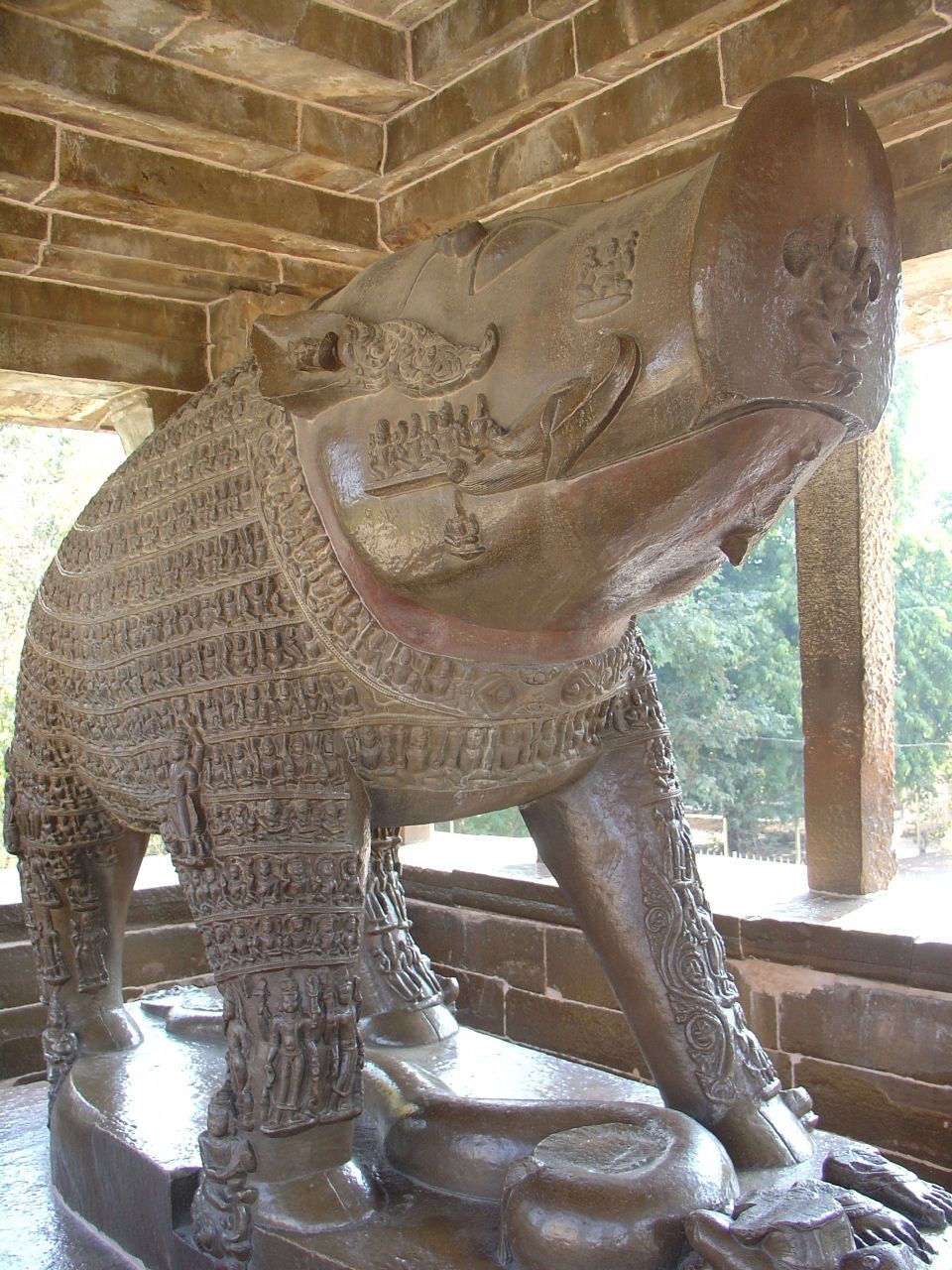
A demon, Hiranyaksha, had prayed for Lord Brahma and got awarded a boon that no beast nor man nor God could kill him. But in some from the lists of beasts, the name of boar was missing, proved to be his lacunae. He then started a campaign of plunder across the worlds. He pushed the world to the Pataal Loka, or "under of the sea". He stole the vedas, the holy scriptures from Lord Brahma, while he was asleep and performed huge atrocities. To retrieve the vedas and to save the world, Lord Vishnu assumed the role of a boar and brought out the earth from the under of the ocean, using its two tusks. It then killed Hiranyaksha, retrieved the vedas from the Asuras and brought them back to the safe custody of Lord Brahma.
04. Narasimha Avatharam
In Narasimha, Lord Vishnu incarnates himself as a semi-man, semi-lion in this world.

The king of demons (Asuras), Hiranyakasyapa, wanted to become immortal and to remain young forever. To this end, he mediated for Lord Brahma and because of his severe penance, the gods were frightened and asked Brahma to pacify the king. Brahma was impressed by his austerity and granted him a wish. Hiranyakasyapa wished that he won't be neither killed by a man or beast, nor in daylight or at night and neither inside or outside a building.
Having obtained the wish, he considered himself the supreme God and frobade all worship of gods by anyone. But his son Prahalada an was ardent devotee of Vishnu. Hiranyakasyapa was so enraged that he ordered numerous ways to kill Prahalada, including asking his sister Holka to sit with Prahalada in fire. But everytime Prahalada escaped unhurt. Enraged, once he asked Prahalada to show him Lord Vishnu and Prahalada said: "He is everywhere". Further enraged, Hiranyakasyapa knocked down a pillar, and asked if Lord was present there. Lord Vishnu then emerged as a half lion, half man from the pillar which was neither inside the house nor outside, and the time was evening, neither night nor day. He then killed Hiranyakasyapa, thus saving the life of his devotee Prahalada.
05. Vamana Avatharam
In Vamana, Lord Vishnu incarnates himself as a dwarf priest in this world.
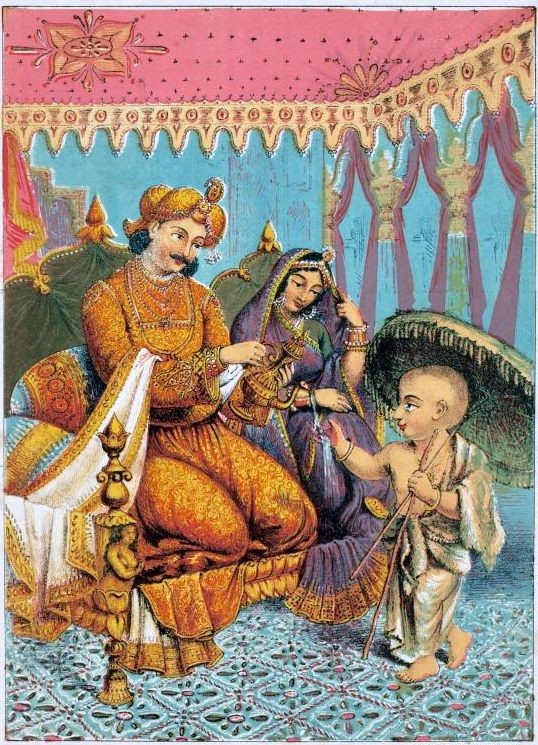
Bali, the grandson of Prahalada was a very valorous and mighty Asura. By his penance and might, he conquered the whole world. Indra and other gods, fearing that the Asuras would conquer all the three worlds, went to Lord Vishnu for help. Lord Vishnu was then born as a dwarf vamana in the household of a Brahman (priest). He went to Bali on growing up and asked for alms. Bali was delighted to offer him anything he requested eventhough his priest warned him it was Lord Vishnu. Vamana then requested for the amount of land that could come under his three feet. Bali gracefully agreed. Lord Vishnu then grew in size and covered the earth and heaven in two strides. And due to lack of space, he put his third leg on Bali himself and crushed him to the Nether or Patala Loka (under world), thus helping gods out.
06. Parasurama Avatharam
In Parasurama, Lord Vishnu incarnates himself as Brahman (priest) in this world.
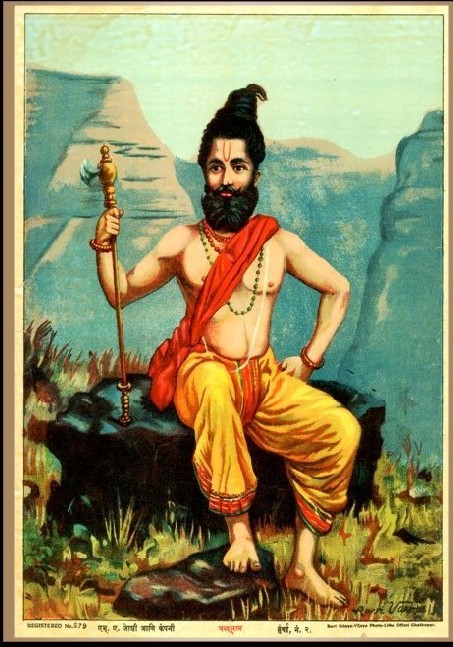
He was brought into this world to avenge all Kshatriyas who had become arrogant and were suppressing the Brahmanas in the world. He was born to Jamadagni and Renuka, and belonged to Brighu clan. Parashurama was always carrying an axe presented to him by Lord Shiva of whom he was an ardent devotee. Kartavirya, a powerful king, once went to Jamadagni's home when he was out, and after a meal, stole the Kamadhenu cow, which was supposed to give endless quantity of milk. Jamadagni was enraged and so, he went and killed the king and brought Kamadhenu back. On hearing this, the son of the king came back and killed Jamadagni. Parashurama was enraged at this and went and avenged the death of his father by killing all Kshatriyas in 21 battles.
07. Rama Avatharam
In Rama, Lord Vishnu incarnates himself as Rama, the central character in the epic "Ramayan". In this epic, it is included the ideal son, ideal husband, ideal king and ideal person.
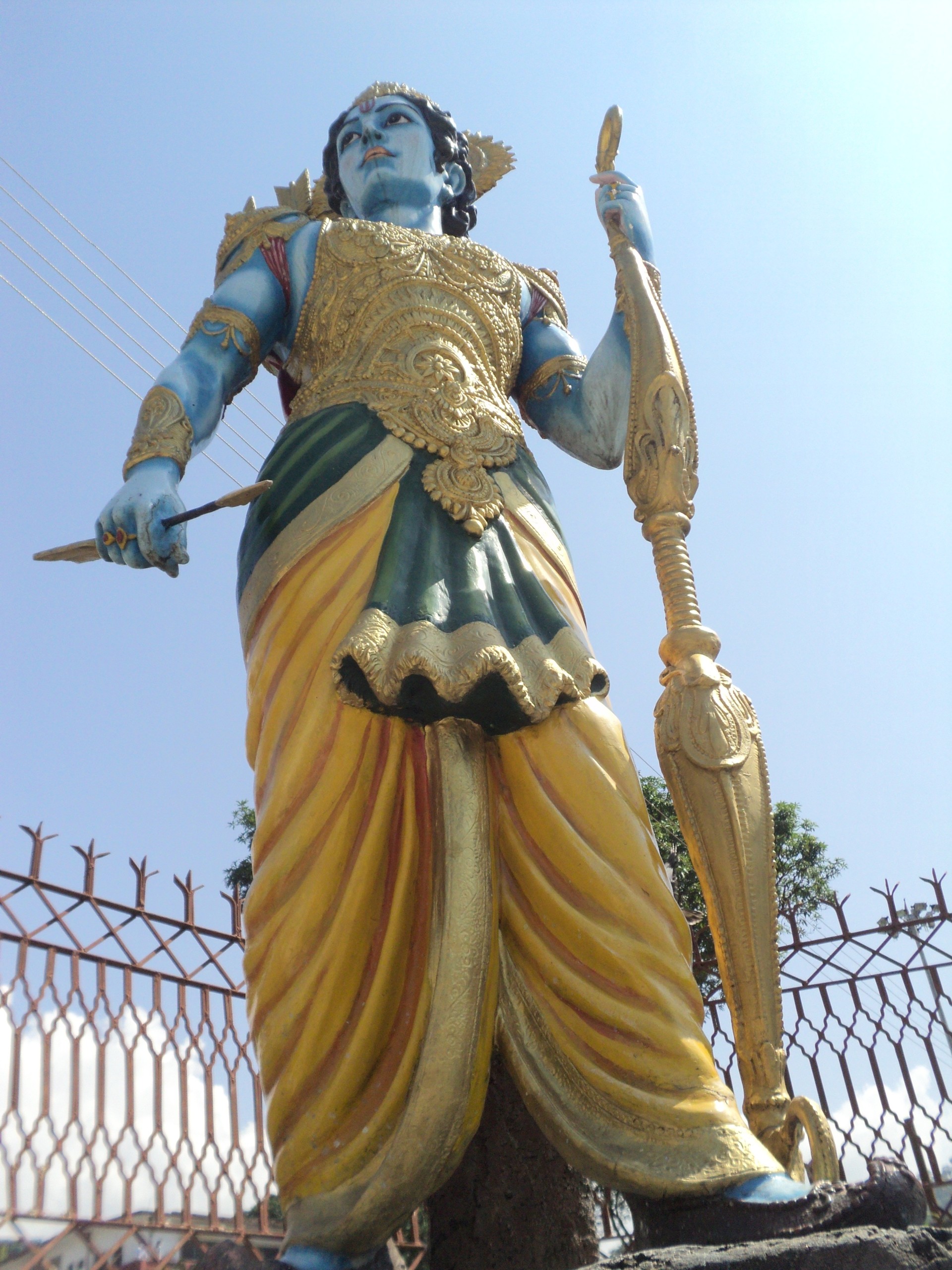
Rama was incarnated in this planet to get rid of the Asura with ten heads (ravana) who had been granted a boon of immunity from gods and other celestial beings by Brahma. Ravana was too vainglorious to be thinking of being vanquished by a man. Hence, Rama was born and Lakshmi, wife of Lord Vishnu, was born as Sita, his wife to be in this life.
The story of Ramayan is an exciting story of war raged by Rama against various evil elements of the world and in the end against Ravana. Ramayan epitomises the ideal behaviour of men, with special focus on man-wife relationship, son-father relationship and the rules for ideal governance by a king.
08. Krishna Avatharam
In Krishna, Lord Vishnu incarnates himself as Krishna, the central character in the epic Mahabharatha.
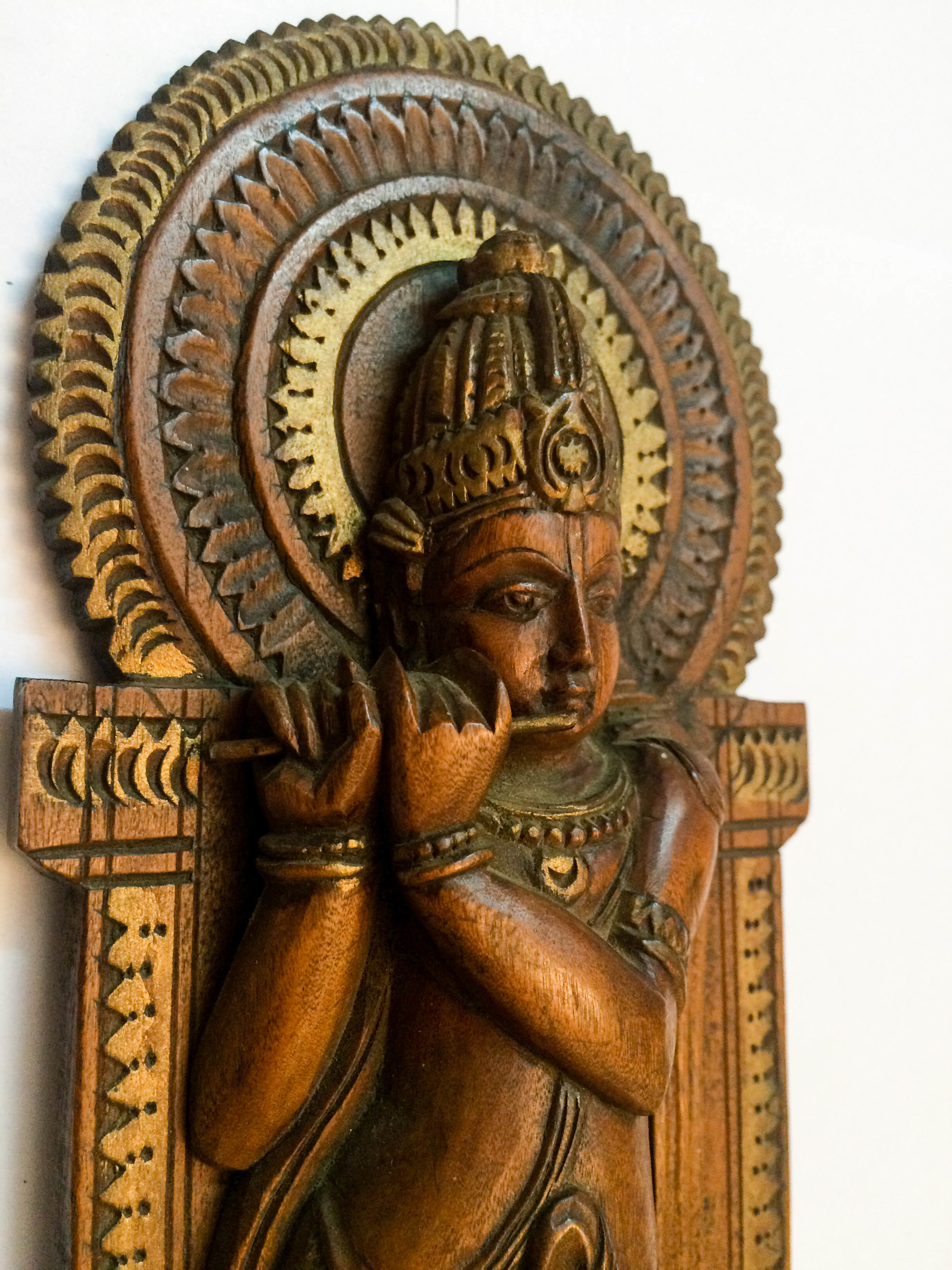
In the biggest epic of Indian mythology a myriad of topics are covered, including war, love, brotherhood, politics, etc. It is essentially, the story of two warring groups of cousin brothers, Pandavas and Kauravas. As a part of the Mahabharatha, during the war, Krishna gives a long discourse to his disciple Arjuna, collectively termed as Bhagavat-gita.
09. Buddha Avatharam
In Buddha, Lord Vishnu incarnates himself as Buddha, the aesthetic prince who renounced the throne to lead the world on the path of peace.
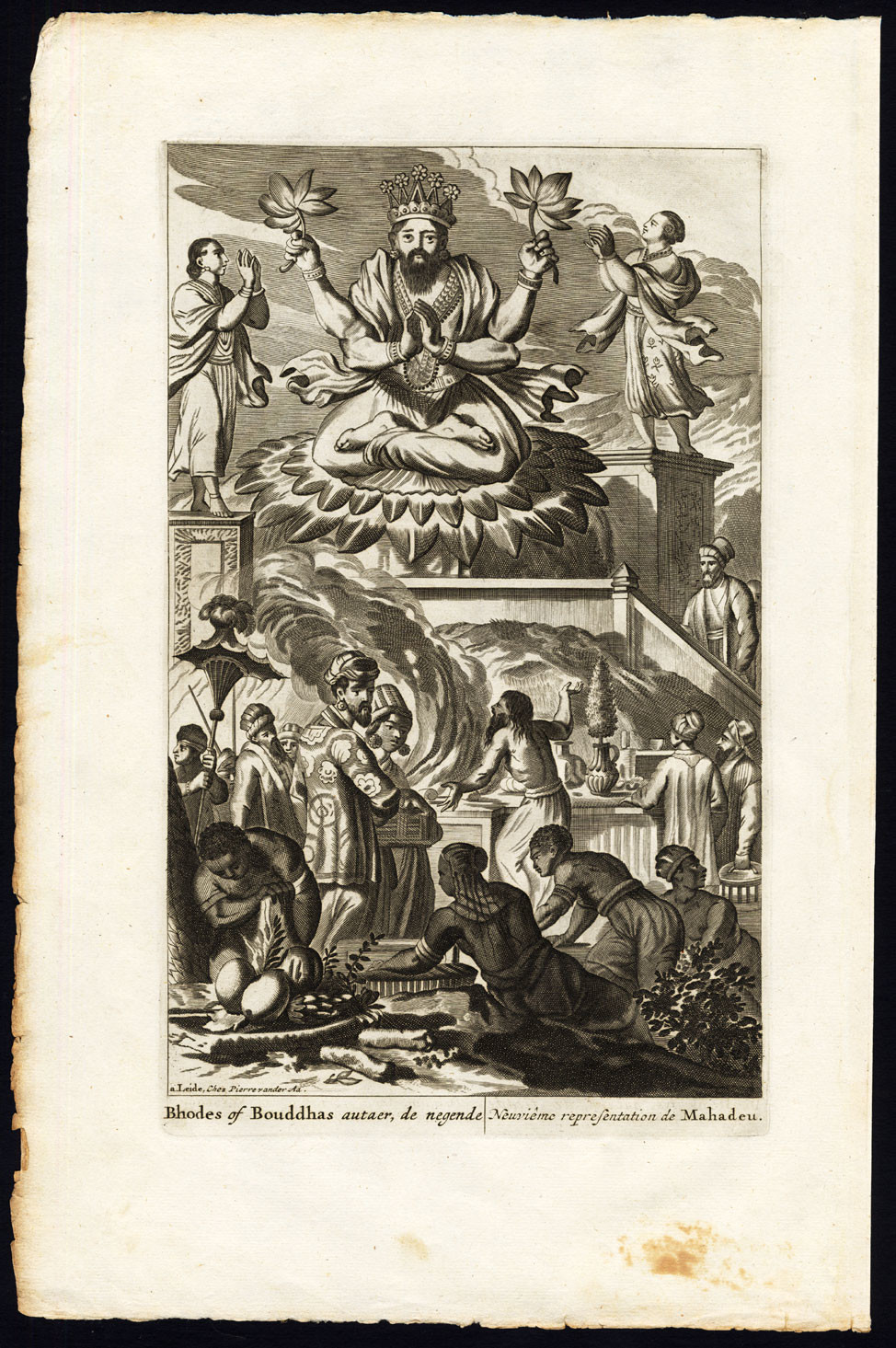
He is the founder of the religion of Buddhism which is very prominent across the world. In certain sects of Hinduism, he is considered to be a divine incarnation of Lord Vishnu. He was born the crown prince of Kapilavasthu to Suddhodana and Maya. He was named Siddhrtha, meaning "all things fullfilled" by the king. His mother died soon after his birth, but Pprajapati, the sister of Maya, brought Siddhartha up.
Buddha was saddened by death of living creatiures since his childhood days and used to question why do people have to suffer and why do the living creatures kill each other. He was not happy with the answer provided to him, so he decided to find out the meaning and the absolute truth. That way, he left his wife and child, became a hermit and began to live in the forest. One day, he became enlightened and his preaching spawned off the religion of Buddhism which is now popular in the whole world.
10. Kalki avatharam
In Kalki, Lord Vishnu incarnates himself as Kalki, the machine man who will come riding his white horse and with blazing sword in his hands.
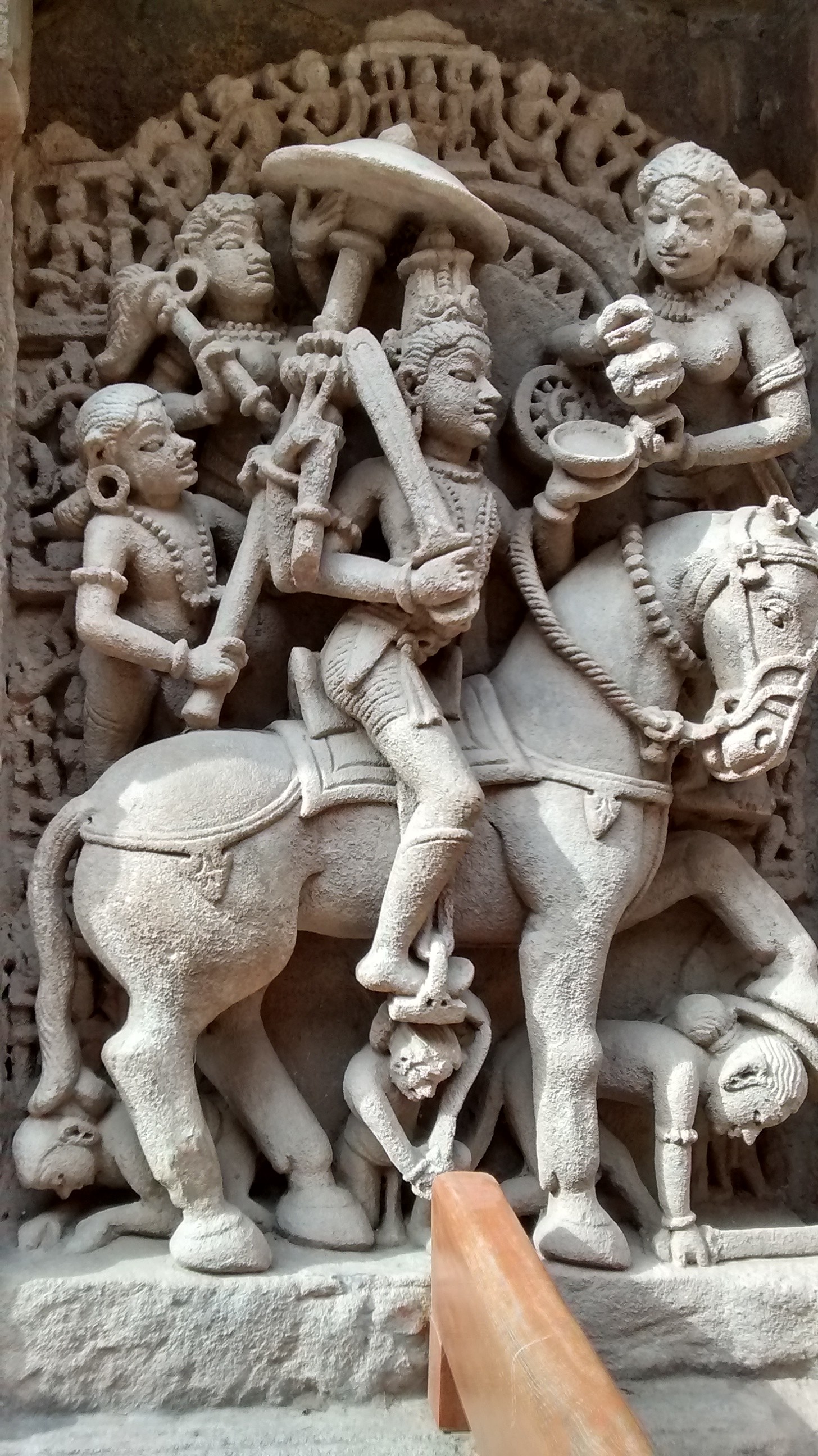
This is supposed to be a future avatar of Lord Vishnu. At the end of the Kaliyuga (present eon), he will punish all evil doers in this world, destroy this world and will recreate a golden age again. Kalki is the last avatar of Lord Vishnu.
"The interpretive stage of Lord Vishnu begins with Lord Shiva"
Curiously, the interpretive stage of Lord Vishnu begins with Lord Shiva. When men's wickedness overran all boundaries, the infuriated Shiva transformed into a wrathful form known as Bhairava. Thus, converted, Shiva began his rampage of destruction, killing, maiming, ripping out hearts of humans and drinking blood, his menacing laughter thundering all around.
On behalf of humanity, Vishnu appeared and approached Bhairava and requested him to stop the slaughter. Bhairava said: "I will go on be killing human beings until my bowl is filled with enough blood to quench my thirst". It was a common knowledge that Bhairava's bowl could never be filled and his thirst never quenched. His heart filled with compassion, Vishnu adressed Shiva: "Let me give you all the blood you need. You don't have to bleed mankind". So, saying, Vishnu struck his forehead with his sword and let his blood spurt into Bhairavas bowl. Ages passed and Vishnu kept on pouring his blood into the bowl and Bhairava kept on drinking.
Bhairava finally realized that Vishnu was sacrificing himself for the sake of the world. Moved by Vishnu's generosity, he declared that: "As long as you protect and preserve the world, I will not seek to quench my thirst. But when the world becomes too corrupted that even you will not be able to handle or sustain it, I will raise my trident and squeeze every drop of blood from the heart of man".
In Hindu esoteric imagination, the supreme and the ultimate reality is believed to reside in the universal soul, which is said to pervade the entire manifested cosmos. The cosmos itself is thought to have evolved from this abstract entity, which is formlesss and devoid of any qualitative attributes. It's neither male nor female and it is infinite, without a begining or end. It is both around us and inside us. The goal indeed of all spiritual practice is to unite with the supreme soul. To the ethernal credit, abstract concepts such as the one, made intelligible to ordinary mortals like you and me through inventions of various forms which make comprehensible the ultimate formless reality. Thus, the Nirguna Brahma becomes Saguna (having qualities) Brahma. The transformed deity is known as Ishvara.
The entire universe, along with the dynamic processes underlying it, is said to stem from Ishvara. For example, when Ishvara creates the universe, he is called Sa Brahma, when he protects it, he is called Vishnu, and when he destroys it, he is called Shiva. Thus, as exemplified in the above legend, Vishnu is the preserver, the protector of all humanity. A deity who saves mankind from calamities which result from its foibles.
Vishnu's image
Vishnu is depicted with four arms and each of it signifies some speacial stages. It is not very astonishing or suprising for the painters to draw the statue of Maha Vishnu, who is believed to be the charming one of all the known three. He is visually represented to depict in clearly perceptible terms, all the composite elements which make up this comprehensive deity.
The number of arms each Hindu deities has are meant merely to be symbolic to manifold the gods powers. Whereas we have limited abilities, a gods power is unlimited, signified by the many hands that holds a variety of attributes and perform myriad activities, often simultaneously.
According to noted indologist Alain Danielou "the image of the deity is merely a group of symbols". The significance of Vishnu as an icon according to Puranaam, Idhigasam and several minor Upanishads is explained in detail. The two most common representation of Vishnu are sleeping casual on Adhisheshan as his bed and standing with his four arms.
The myth behind his depiction
Vishnu's four hands dominion over the four directions of space.
01. North
02. South
03. East
04. West
Some also believe that the four arms represents the four stages of human life, known as four Acharams.
01. The quest for knowledge (Brahmacharya)
02. Family life (Grihastha)
03. Retreat into the forest (Vanaprastha)
04. Renunciation (Sannyasa)
It is also believed that it depicts the four duties of life.
01. Duty and virtue (Dharma)
02. Material goods, wealth and sucess (Artha)
03. Pleasure, sexuality and enjoyment (Kama)
04. Liberation (Moksha)
Likewise, the four arms represent the four vedas or the four caste.
01. Rigveda
02. Yajurveda
03. Sasmaveda
04. Atarvaveda
(Or)
01. Brahmins/Andhanas: The learnt/priestly people.
02. Kshatriyas: The warriors of valour.
03. Vaishiyas: Merchants.
04. Shudras: The landless labours.
Further, Lord Vishnu holds the following implements in his hands:
01. Conch
02. Discus
03. Lotus
04. Mace
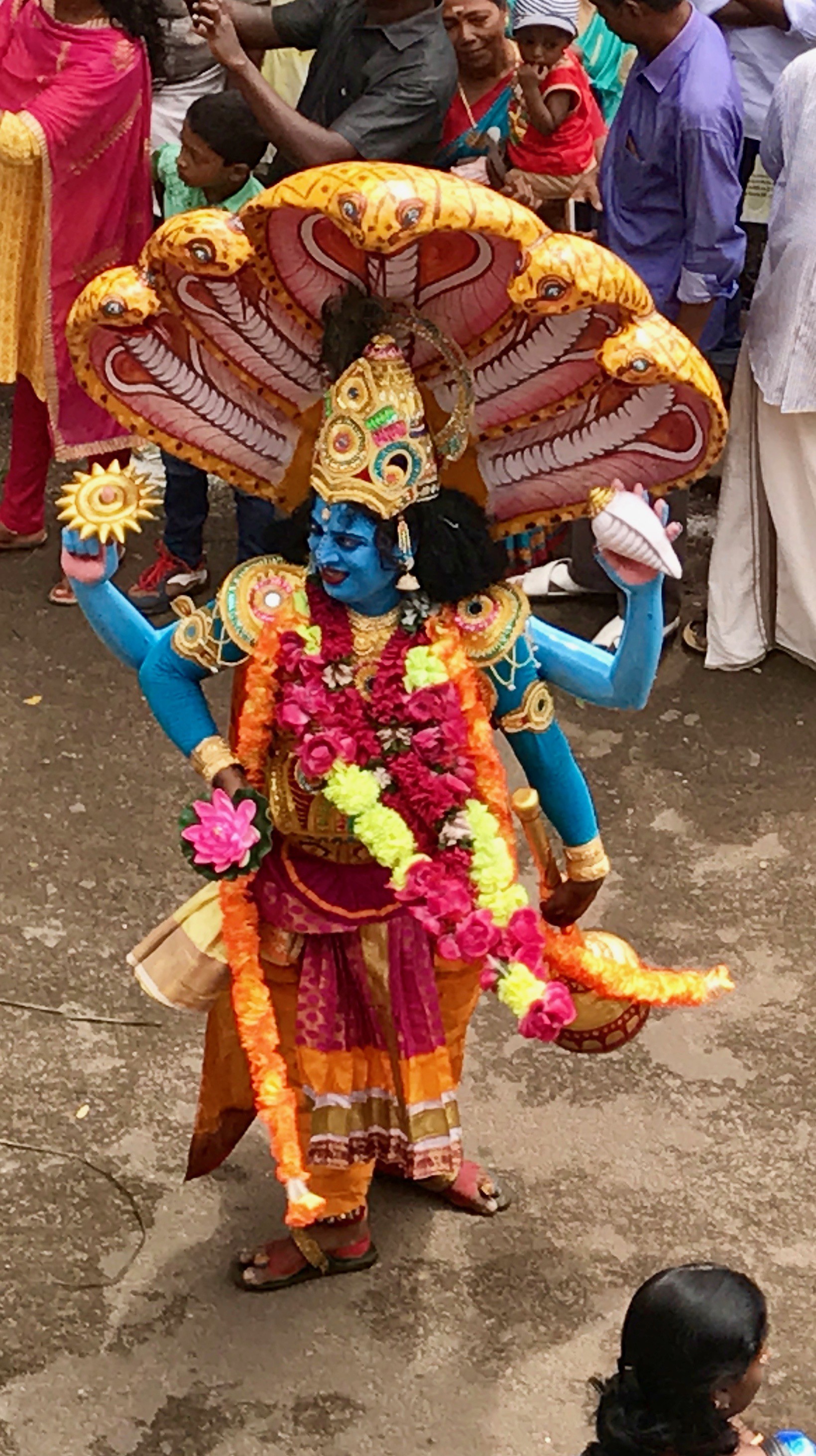
This is one of the most important emblems of Vishnu. The blowing of conch symbolizes the primodial creative voice and Indian mysticism links it to the sacred sound "om", which is said to be breath of Vishnu, pervading all space.
Its convolusions are variously suggested as the rising and setting sun, hence, further cementing Vishnu's solar associations. The conch has the form of a multiple spiral evolving from one point into ever increasing spheres. It thus denoted eternity, since it may go on forever.
It is the discus.
The ancient Vishnu Purana identifies the chakra with the human mind whose thoughts, like the chakra, flow faster than ever than the mightiest wind. When used as a weapon, the distinguishing feature of the chakra is its ability to return to the hand of the one who throws it.
The only other weapon which is said to have this quality is the boomerang. Perhaps, this is a pointer to the cyclic nature of existence. Indeed, some scholars discern a parallel with a water wheel (the one used in early times), viewing the worlds as a constant and cyclic interplay of irreconcilable activities (duality). The water wheel both empties and fills its vessels, turning without end to bring up water and disgorge it into forever parched fields. So does life fills and empties, due to forces innate in nature. This is the constant and rhythmic turning of the wheel of life.
When Vishnu contemplated the creation of mankind, a lotus sprang out of his navel. Seated on it, there was the four headed Brahma, illuminating all the directions with his brightness.
Vishnu was there for called Padmanabha (padma: lotus), (nabham from nabhikamalam: navel), "the one with a lotus on his navel". The lotus lit up the sky with its effulgence and was identified with the sun. As it was the creative matrix which all of the world eventually evolved, the lotus thereby became a symbol of creation and fertility. By rising from the depths of the ocean where are said to dwell impure creatures like demons and serpents, the lotus also expresses purity. Likewise does the individual soul, though rooted in an imperfect world, search for perfection.
The lotus in Vishnu's hands also denotes his better half and constant companion, the source from which he derives his powers, namely godess Lakshmi. Lakshmi is the godess of prosperity, who sits on a lotus stalks with the same flower in her hands. Thus the lotus is also the feminine force that activates the creative power of Lord Vishnu, like Shakthi does for her Shiva.
The lotus further signifies the well-known yogic ideal of detachment. This is because this beautiful though flower often grows in muddy waters and neither water nor dirt are ever seen sticking to its petals. Indeed Vishnu's message is an empty reflected in lotus, and inform us to partake of life's pleasures, without getting ensnared by them.
There once lived a mighty demon named Gada who, intoxicated with his powers on the battlefield, continued to wreck on all humanity. Finally, it came upon Vishnu to provide succor to harassed mankind. Famed universally for his valour, Gada was equally known for his charitable inclination. It was said that he wouldn't refuse a boon to any individual however unresonable the demand may be.
Vishnu approached Gada as a Brahmin and addressed him. This is supported by the Krishna Upanishad which says that "the mace is kali, the power of time. It destroys all that opposes it". Thus does Vishnu describe it himself: "The world rests as the lotus in the palm of my hand, the cosmos revolves my finger like a discus. I blow the music of life through my conch and wield my mace to protect all creatures".
In visual imagery an upright Vishnu stands with each of his four arms holding a different symbolic attribute. He is straight as a post, for he is the firm centre, and the axis of the universe, he is the sturdy pillar who joins the earth to the heavens. Indeed to his devotees, a formal, a hieratic representation of Vishnu, their refuge and protector, standing like a mighty pillar comforting sight.
The other popular icon of Vishnu
He is shown in a dream like state reclining upon a mighty serpent and floating upon the primodial waters. This image of Vishnu is at the purest. This pure Vishnu principle is the source and plan of life. It is identified with the world of dream, where things are conceived as prototypes yet to be realized. The real, lasting creation is this mental creation. We create machine when we conceive it. Once the plans are made in the abstract, realization is perishable materials in secondary matter which the inventor may leave technitians. World planning is the work of Vishnu, who symbolises the universal intellect.
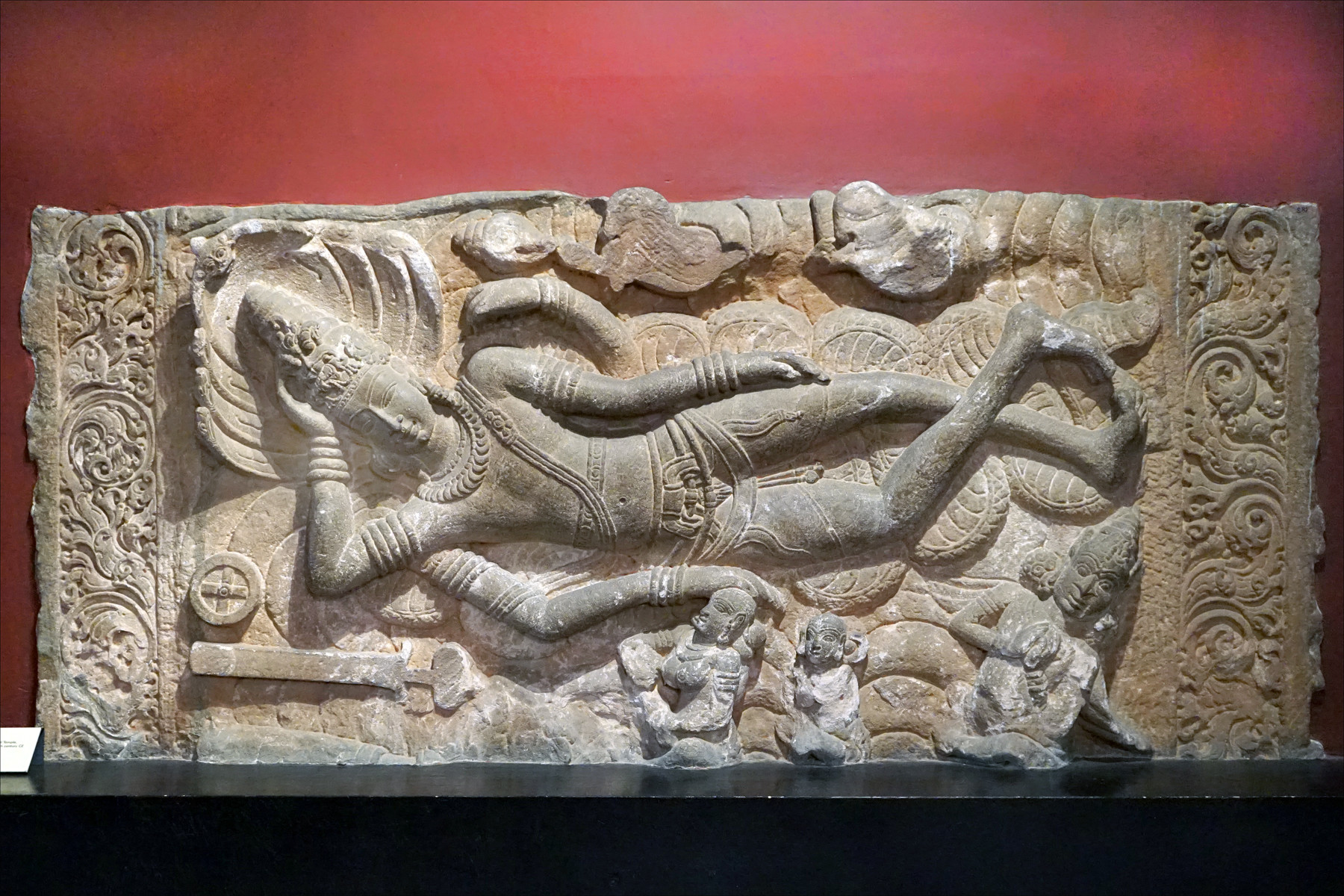
The three states of mind (sleep, dream, awareness) are the relative conditions corresponding to the Hindu Trinity. Thus, Shiva is experienced in the dreamless sleep, Vishnu in the vision of dreams and Brahma in the state of awareness. Vishnu in his dreams represents that gap in time when creation stands withdrawn and eternity awaits birth of a new age.
When creation is withdrawn it cannot easily cease to be; there must remain in a subtle form the germ of all that has been and will be so that the world may rise again. It is the remainder of the destroyed universes which is embodied in the serpent floating on waters, known as Sheshanaga (shesh: remainder). At the physical plane, it is parallel to the sperm floating in the germinating waters of the womb where creation can happen at any instant.
This measureless ocean is the pure consciousness on which wafts the divine spark of energy which is the harbinger of the creative activity about to materialize. According to some mythological sayings: "the source of all creation is pure consciousness. Pure potentialty seeking expression from the unmanifest to the manifest". The same author brings to our notice that Vishnu resides inside each of us. He is present in the silent space which exists between our two consecutive thoughts. The two consecutive thoughts represent the two sequential ages and the silence between them is the fathomless ocean of infinite possibilities. When we are able to inject in this space our intention to create (or achieveany specific goals) the result is the fulfilment of our desires in resonance with the creative rhythms of nature. It is this divine and fertilizing seed that Vishnu signifies.
There are assumed forms known to Hindus by Vishnu
01. Para form
Para is the highest form of Vishnu found only in the Vaikuntam, along with his consort Lakshmi (and Bhuma Devi and Nila Devi, avatars of Lakshmi), and surrounded by liberated souls like Ananta, Garuda and a host of Mukhtas (liberated souls).
02. Vyuha form
He is assumed to take four forms himself, which exercise different cosmic functions and controls activities of living beings.
03. Vibhava form
Vishnu assumes various manifestations, called Vibhavas, more popularly known as avatars from time to time, in order to protect the virtuous, punish the evil-doers and re-establish righteousness.
04. Antaryani; "dwelling within" or Suksama Vasudeva form
Vishnu exists within the souls of all living beings and in every atom of matter.
05. Arcavatara or image manifestation
The lord is easily approachable to the devotees since they cannnot worship Para, Vyuha and Vibhava and Antaryani forms directly, which can be only imagined or mediated upon because they are beyond our reach. Such images can be:
A.
Revealed by the Lord himself, for example, a self-manifested (Wwambhu) icon (Murti), e. g. : The Maha Vishnu temple at Tirunelveli, the Sri Aranganatha Swamy temple at Srirangam and the Tirumala Venkateshwara temple, etc.
B.
Installed by Devargal or celestial beings such as Guruvayur temple installed by Vayu.
Photo gallery
Content available in other languages
- Français: VISHNOUISME ET DARWINISME
- Italiano: Visnuismo e Darwinismo
- Español: VAISNAVISMO Y DARWINISMO
Rate and comment about this place!
Do you know Dhasavathara Sthalangal? Share your opinion about this place.





























